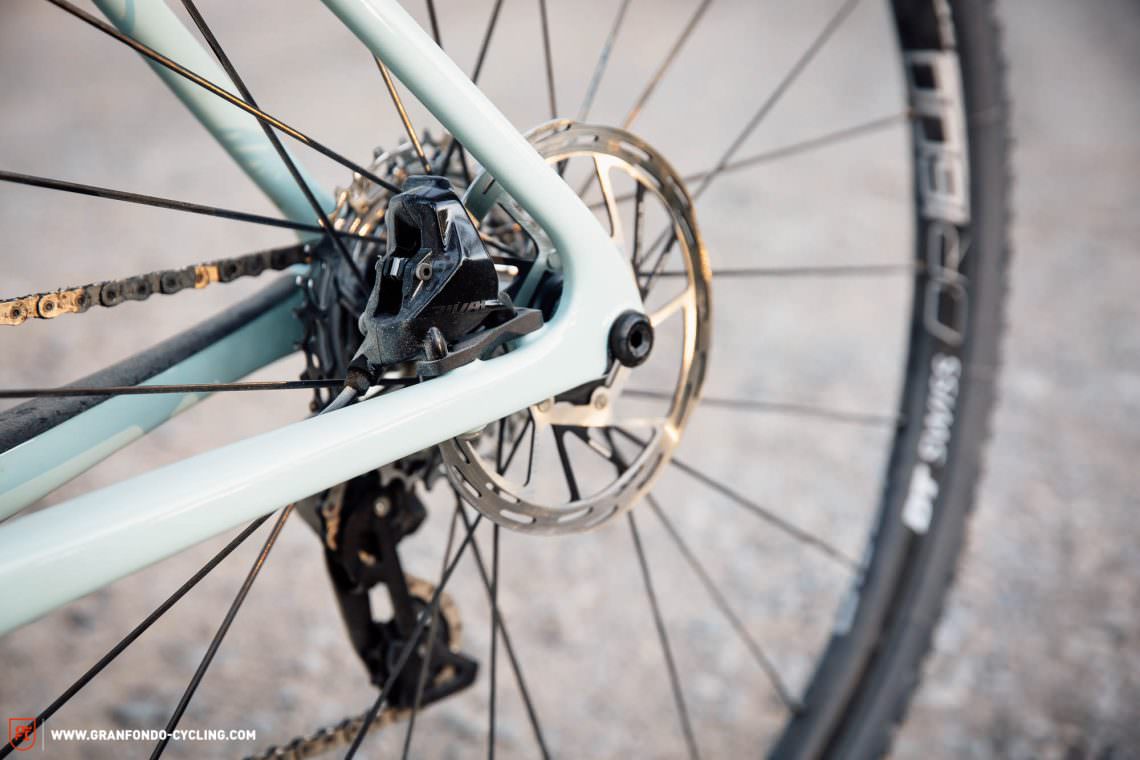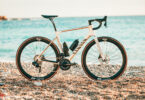With the Cannondale SuperSix EVO SE, the American brand are expanding their model range with a second gravel bike designed for fast rides on hard-packed gravel. This group test with 18 of the best gravel bikes of the year looks at how the concept works with its electronic 2x groupset.
For an overview of the test fleet head to the group test: The best gravel bike 2022 – 19 models on test

Last year, the pros of Team EF Education-EasyPost had to use modified SuperSix EVO Hi-Mods (read review here) for some gravel races. Cannondale have remedied the situation and launched a bike that looks like a road racer and, with the same performance focus, is optimised for gravel and cyclocross use. Like the SuperSix EVO CX, the bike is UCI-legal and ready for cyclocross races, though we had the SuperSix EVO SE with its wider tires in our test. For both models, the secret sauce is in the geometry: with a slack 70° head angle and the correspondingly large distance between the bottom bracket and the front axle, as well as the short chainstays, the bike should produce handling that combines stability and agility in the best possible way.



For the drivetrain, the Cannondale SuperSix EVO SE relies on a 2x SRAM Rival eTap AXS groupset – the cheapest electronic in the SRAM portfolio. Although it keeps the price point of the bike within limits at € 4,999, it is also slower and feels less snappy than its Force and RED-level counterparts. The 46/33 t chainrings and 10–36 t cassette are also more reminiscent of a road bike. At high speeds, you can happily pedal along and appreciate the small steps in the gears. However, on steep ramps, you may end up running out of steam. A larger gear range and easier gearing even at the expense of the small gear steps, would be more desirable to allow riders of all fitness levels to cover even more terrain.

The seat post clamp bolt is located under the top tube, hidden from view. It is easy to reach and contributes to the clean appearance of the bike. That’s how we like integration.

The brake lines of the SuperSix EVO SE are only partially integrated, disappearing into the fork and down tube. Since the bike shifts wirelessly, the cable tangle is kept within limits though.

A green saddle might be a matter of taste but we’d prefer to stick with black, even if you’re usually sitting on it. Maybe the colour represents the hope for more different versions of the bike.
Cannondale SuperSix EVO SE
€ 4,999
Specifications
Seatpost HollowGram 27 SL KNØT
Brakes SRAM Rival eTap AXS HRD 160/160 mm
Drivetrain SRAM Rival eTap AXS 2x12
Stem Cannondale 2 100 mm
Handlebar Cannondale 2 410 mm
Wheelset DT Swiss CR1600 SPLINE
Tires Vittoria Terreno Dry Tubeless Ready Graphene 2.0 700 x 38C
Technical Data
Size 46 51 54 56 58
Weight 8.72 kg
Specific Features
wireless shifting on a budget
excellently integrated seat post clamp
modern road bike looks
premium Vittoria Terreno Graphene 2.0 tires

The SRAM Rival eTap AXS groupset has its place, but not in the gravel segment with the 10–36 t cassette. The range is simply too small, especially uphill.

The SuperSix EVO SE needs an adapter for a 160 mm rear brake disc. If you want to attach the brake caliper directly into the frame, you’ll need a 140 mm disc, which won’t be enough for most gravel scenarios.

Cannondale have provided clearances for tires up to 45 mm wide on the SuperSix EVO SE. This is sufficient for the character of the bike and, with the 41mm (measured) Vittoria tires fitted, there is still plenty of room left.


The drivetrain and cockpit are more suited to a pure road bike – Cannondale, improvements are possible here!
| Size | 46 | 51 | 54 | 56 | 58 |
|---|---|---|---|---|---|
| Seat tube | 449 mm | 488 mm | 524 mm | 546 mm | 566 mm |
| Top tube | 507 mm | 524 mm | 537 mm | 555 mm | 568 mm |
| Head tube | 93 mm | 110 mm | 132 mm | 153 mm | 175 mm |
| Head angle | 70.0° | 71.0° | 71.0° | 71.0° | 71.0° |
| Seat angle | 73.9° | 73.1° | 73.1° | 72.7° | 72.7° |
| Chainstays | 422 mm | 422 mm | 422 mm | 422 mm | 422 mm |
| BB Drop | 70 mm | 70 mm | 69 mm | 69 mm | 68 mm |
| Wheelbase | 1,002 mm | 1,005 mm | 1,020 mm | 1,034 mm | 1,048 mm |
| Reach | 365 mm | 371 mm | 378 mm | 385 mm | 392 mm |
| Stack | 515 mm | 535 mm | 555 mm | 575 mm | 595 mm |

Pants Ostroy Camper Cargo Bibs | Shoes Giro Sector | Socks Ostroy In It For The Pics
Also desirable: a slightly wider handlebar with flare. The Cannondale 2 aluminium handlebar with its 420 mm width and 0° flare is more suited to road applications and feels mismatched to the bike’s intentions. The same applies to the DT Swiss CR 1600 Spline wheels which, with their 22 mm inner width, are a little too narrow for modern gravel. As a result, the 700 x 38C Vittoria Terreno Dry Tubeless Ready Graphene 2.0 tires inflate somewhat like balloons. Nonetheless, the tires measured 41 mm wide and convince even on loose ground thanks to their cornering grip and low rolling resistance on hardpack. It’s not for nothing that this tire was the winner in our last gravel tire group test (read the review here).

But to enjoy the bike’s good efficiency, you first have to get it up to speed, which doesn’t happen quite as easily as on the best bikes in the test. You can clearly feel the bike’s 8.72 kg weight and the increased rotational mass of the aluminium wheels. This also has an effect on steep climbs, where a lot of power is needed to keep the bike moving at a low cadence. However, when going downhill or over the flats, the SuperSix EVO SE shows its efficiency and you can keep on pushing along at high speed thanks to the heavy gears.


Tuning tips: carbon gravel wheels with more inner width | wider handlebar with flare
You can reliably come to a stop with the SRAM Rival eTap AXS HRD brakes, which come with 160 mm rotors front and rear. Only on very loose ground do the tires lack a bit of braking grip and thus traction. When it comes to the geometry, Cannondale’s approach works out perfectly, because the SuperSix EVO SE convinces with intuitive and very balanced handling that doesn’t overwhelm any rider. The focus is on stable handling and a smooth ride. Nevertheless, agility isn’t sacrificed and sporty changes of direction are also easy. This means that the bike is more likely to be found on wide gravel highways with long, open curves and moderate climbs than on winding trails with many metres of ascending. The gear ratio is sufficient for this. In terms of comfort, the Cannondale is solid: the riding position is compact and centrally integrated with the bike, while the SRAM Rival levers fit nicely in the hand. The frame and the Vittoria tyres dampen vibrations and small impacts well, but larger impacts are clearly noticeable. This is where the aluminium components of the cockpit and the wheels reach their limits. With a little carbon tuning, the comfort could be considerably improved.
Riding Characteristics
4Agility
- cumbersome
- playful
Stability
- nervous
- confident
Handling
- demanding
- balanced
Fun factor
- boring
- lively
Comfort
- firm
- comfortable
Value for money
- terrible
- very good
Cannondale SuperSix EVO SE conclusion
Cannondale’s SuperSix EVO SE is a well-executed concept and a sensible addition to the gravel portfolio. Above all, the frameset with its balanced handling, decent tire clearances and hot looks convinces as a very good foundation for all-round use on gravel. However, the components used unnecessarily limit the bike and prevent a podium finish. We hope for further, higher-quality and more gravel specific builds with which the bike could have a real say in the fight for victory.
Tops
- balanced, intuitive handling
- good design reminiscent of a road bike
- frame is a very good basis for all-round use
Flops
- too heavy
- narrow handlebars without flare
- aluminium wheelset limits performance

You can find out more about at cannondale.com
The testfield
For an overview of the test fleet head to the group test: The best gravel bike 2022 – 19 models on test
All bikes on review: 3T Exploro Ultra (Click for review) | BMC URS LT ONE (Click for review) | Cannondale SuperSix EVO SE | Canyon Grizl CF SLX 8 eTap Suspension (Click for review) | Cervélo Áspero GRX Di2 (Click for review) | CUBE Nuroad C:62 SLT (Click for review) | Curve Kevin of Steel III (Click for review) | Falkenjagd Aristos R (Click for review) | Felt Breed 20 (Click for review) | FOCUS ATLAS 6.8 (Click for review) | GIANT Revolt Advanced 0 (Click for review) | OPEN WI.DE. (Click for review) | Ridley Kanzo Fast (Click for review) | ROSE BACKROAD EKAR LTD (Click for review) | SCOTT Addict Gravel Tuned (Click for review) | Specialized S-Works Crux (Click for review) | Stelbel Nina XCr (Click for review) | Storck GRIX.2 Platinum (Click for review) | Wilier Rave SLR (Click for review)

No, it’s not about perfect race tracks, it’s about efficiency. Fast, fleet-footed and efficient – those who want to speed along high-speed passages need a defined and spritely bike that accelerates with ease and efficiency. Nevertheless, reliable components are important too. We interpret “Smooth tarmac” bikes as follows: Hard efforts at high speeds with a maximum efficient bike on a consistently well-paved road. Effort-joy ratio: 80:30 (not everything has to be 100%!)↩
… also known as bike riding. Broken-up roads in the hinterland, deadlocked gravel roads, loose surfaces – sometimes muddy, sometimes bone-dry. For this, it takes bikes with super all-round, handling and wearing qualities uphill and downhill. Effort-joy ratio: 50:50↩
If you want to use your bike almost every day, you usually do not need an extremely tuned racing machine. Solid components, which are able to cope with the rigours of continuous usage in any kind of weather, are part of the basic equipment. At the same time, the bike should have practicable details: integrated fenders/assembly options, luggage racks/attachment points and a light system or at least the option of installing bike lights. The position on the bike should be rather relaxed, the overall comfort high, so that the Afterwork Ride becomes a cure and not a curse. Effort-joy ratio: 30:70↩
You can find more info about our rating system in this article: Click here! ↩
Did you enjoy this article? If so, we would be stoked if you decide to support us with a monthly contribution. By becoming a supporter of GRAN FONDO, you will help secure a sustainable future for high-quality cycling journalism. Click here to learn more.
Words: Photos: Benjamin Topf, Peter Walker







